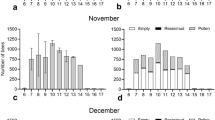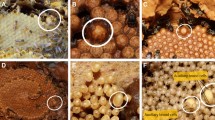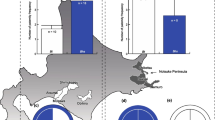Abstract
In order to identify genes that are influencing defensive behaviors, we have taken a new approach by dissecting colony-level defensive behavior into individual behavioral measurements using two families containing backcross workers from matings involving European and Africanized bees. We removed the social context from stinging behavior by using a laboratory assay to measure the stinging response of individual bees. A mild shock was given to bees using a constant-current stimulator. The time it took bees to sting in response to this stimulus was recorded. In addition, bees that were seen performing guard behaviors at the hive entrance were collected. We performed QTL mapping in two backcross families with SNP probes within genes and identified two new QTL regions for stinging behavior and another QTL region for guarding behavior. We also identified several candidate genes involved in neural signaling, neural development and muscle development that may be influencing stinging and guarding behaviors. The lack of overlap between these regions and previous defensive behavior QTL underscores the complexity of this behavior and increases our understanding of its genetic architecture.



Similar content being viewed by others
References
Ammons AD, Hunt GJ (2008) Identification of quantitative trait loci and candidate genes influencing ethanol sensitivity in honey bees. Behav Genet 38:531–553
Arechavaleta-Velasco ME, Hunt GJ (2004) Binary trait loci that influence honey bee (Hymenoptera : Apidae) guarding behavior. Ann Entomol Soc Am 97:177–183
Arechavaleta-Velasco ME, Hunt GJ, Emore C (2003) Quantitative trait loci that influence the expression of guarding and stinging behaviors of individual honey bees. Behav Genet 33:357–364
Awasaki T, Tatsumi R, Takahashi K, Arai K, Nakanishi Y, Ueda R, Ito K (2006) Essential role of the apoptotic cell engulfment genes draper and ced-6 in programmed axon pruning during Drosophila metamorphosis. Neuron 50:855–867
Beye M, Gattermeier I, Hasselmann M, Gempe T, Schioett M, Baines JF, Schlipalius D, Mougel F, Emore C, Rueppell O, Sirvio A, Guzman-Novoa E, Hunt G, Solignac M, Page RE (2006) Exceptionally high levels of recombination across the honey bee genome. Genome Res 16:1339–1344
Boquet I, Hitier R, Dumas M, Chaminade M, Preat T (2000) Central brain postembryonic development in Drosophila: implication of genes expressed at the interhemispheric junction. J Neurobiol 42:33–48
Boyle M, Nighorn A, Thomas JB (2006) Drosophila Eph receptor guides specific axon branches of mushroom body neurons. Development 133:1845–1854
Breed MD, Rogers KB (1991) The behavioral-genetics of colony defense in honey bees: genetic variability for guarding behavior. Behav Genet 21:295–303
Breed MD, Robinson GE, Page RE (1990) Division-of-labor during honey-bee colony defense. Behav Ecol Sociobiol 27:395–401
Breed MD, Guzman-Novoa E, Hunt GJ (2004) Defensive behavior of honey bees: organization, genetics, and comparisons with other bees. Annu Rev Entomol 49:271–298
Burgo A, Sotirakis E, Simmler MC, Verraes A, Chamot C, Simpson JC, Lanzetti L, Proux-Gillardeaux V, Galli T (2009) Role of Varp, a Rab21 exchange factor and TI-VAMP/VAMP7 partner, in neurite growth. EMBO Rep 10:1117–1124
Burrell BD, Smith BH (1994) Age-related but not caste-related regulation of abdominal mechanisms underlying the sting reflex of the honey-bee, Apis-mellifera. J Comp Physiol A Sens Neural Behav Physiol 174:581–592
Collins AM, Rinderer TE, Harbo JR, Bolten AB (1982) Colony defense by Africanized and European honey bees. Science 218:72–74
Collins AM, Rinderer TE, Tucker KW, Pesante DG (1987) Response to alarm pheromone by European and Africanized honeybees. J Apic Res 26:217–223
Collins AM, Rinderer TE, Tucker KW (1988) Colony defense of two honeybee types and their hybrid. I. Naturally mated queens. J Apic Res 27:137–140
Dearborn R, He Q, Kunes S, Dai Y (2002) Eph receptor tyrosine kinase-mediated formation of a topographic map in the Drosophila visual system. J Neurosci 22:1338–1349
Dennis G Jr, Sherman BT, Hosack DA, Yang J, Gao W, Lane HC, Lempicki RA (2003) DAVID: database for annotation, visualization, and integrated discovery. Genome Biol 4:P3
Dierick HA, Greenspan RJ (2007) Serotonin and neuropeptide F have opposite modulatory effects on fly aggression. Nat Genet 39:678–682
Dorsten JN, Kolodziej PA, VanBerkum MFA (2007) Frazzled regulation of myosin II activity in the Drosophila embryonic CNS. Dev Biol 308:120–132
Dupuis J, Siegmund D (1999) Statistical methods for mapping quantitative trait loci from a dense set of markers. Genetics 151:373–386
Eggert T, Hauck B, Hildebrandt N, Gehring WJ, Walldorf U (1998) Isolation of a Drosophila homolog of the vertebrate homeobox gene Rx and its possible role in brain and eye development. Proc Natl Acad Sci USA 95:2343–2348
Eisenhardt D, Kuhn C, Leboulle G (2006) The PKA-CREB system encoded by the honeybee genome. Insect Mol Biol 15:551–561
Fuentes-Medel Y, Logan MA, Ashley J, Ataman B, Budnik V, Freeman MR (2009) Glia and Muscle Sculpt Neuromuscular Arbors by Engulfing Destabilized Synaptic Boutons and Shed Presynaptic Debris. PLoS Biol 7(8). doi:10.1371/journal.pbio.1000184
Gervasi N, Tchenio P, Preat T (2010) PKA dynamics in a Drosophila learning center: coincidence detection by rutabaga adenylyl cyclase and spatial regulation by dunce phosphodiesterase. Neuron 65:516–529
Guzman-Novoa E, Page RE, Spangler HG, Erickson EH (1999) A comparison of two assays to test the defensive behaviour of honey bees (Apis mellifera). J Apic Res 38:205–209
Guzman-Novoa E, Hunt GJ, Uribe JL, Smith C, Arechavaleta-Velasco ME (2002) Confirmation of QTL effects and evidence of genetic dominance of honeybee defensive behavior: results of colony and individual behavioral assays. Behav Genet 32:95–102
Guzman-Novoa E, Hunt GJ, Uribe-Rubio JL, Prieto-Merlos D (2004) Genotypic effects of honey bee (Apis mellifera) defensive behavior at the individual and colony levels: the relationship of guarding, pursuing and stinging. Apidologie 35:15–24
Guzman-Novoa E, Hunt GJ, Page RE, Uribe-Rubio JL, Prieto-Merlos D, Becerra-Guzman F (2005) Paternal effects on the defensive behavior of honeybees. J Hered 96:376–380
Hanson BJ, Hong WJ (2003) Evidence for a role of SNX16 in regulating traffic between the early and later endosomal compartments. J Biol Chem 278(36):34617–34630
Hauser F, Cazzamali G, Williamson M, Blenau W, Grimmelikhuijzen CJP (2006) A review of neurohormone GPCRs present in the fruitfly Drosophila melanogaster and the honey bee Apis mellifera. Prog Neurobiol 80:1–19
Huang DW, Sherman BT, Lempicki RA (2009) Systematic and integrative analysis of large gene lists using DAVID bioinformatics resources. Nat Protoc 4:44–57
Hummel T, Schimmelpfeng K, Klambt C (1999) Commissure formation in the embryonic CNS of Drosophila I. Identification of the required gene functions. Dev Biol 209:381–398
Hunt GJ (2007) Flight and fight: a comparative view of the neurophysiology and genetics of honey bee defensive behavior. J Insect Physiol 53:399–410
Hunt GJ, Guzman-Novoa E, Fondrk MK, Page RE (1998) Quantitative trait loci for honey bee stinging behavior and body size. Genetics 148:1203–1213
Hunt GJ, Guzman-Novoa E, Uribe-Rubio JL, Prieto-Merlos D (2003) Genotype-environment interactions in honeybee guarding behaviour. Anim Behav 66:459–467
Johnson BR (2008) Within-nest temporal polyethism in the honey bee. Behav Ecol Sociobiol 62:777–784
Kawasaki F, Iyer J, Posey LL, Sun CE, Mammen SE, Yan H, Ordway RW (2011) The disabled protein functions in CLATHRIN-mediated synaptic vesicle endocytosis and exoendocytic coupling at the active zone. Proc Natl Acad Sci USA 108:E222–E229
Koch I, Schwarz H, Beuchle D, Goellner B, Langegger M, Aberle H (2008) Drosophila ankyrin 2 is required for synaptic stability. Neuron 58:210–222
Kolmes SA, Fergusson-Kolmes LA (1989) Measurements of stinging behaviour in individual worker honeybees (Apis mellifera L.). J Apic Res 28:71–78
Lapidge KL, Oldroyd BP, Spivak M (2002) Seven suggestive quantitative trait loci influence hygienic behavior of honey bees. Naturwissenschaften 89:565–568
Mackay TFC (2004) The genetic architecture of quantitative traits: lessons from Drosophila. Curr Opin Genet Dev 14:253–257
Moore AJ, Breed MD, Moor MJ (1987) The guard honey bee-ontogeny and behavioral variability of workers performing a specialized task. Anim Behav 35:1159–1167
Paxton RJ, Sakamoto CH, Rugiga FCN (1994) Modification of honey bee (Apis mellifera L.) stinging behaviour by within-colony environment and age. J Apic Res 33:75–82
Pielage J, Steffes G, Lau DC, Parente BA, Crews ST, Strauss R, Klambt C (2002) Novel behavioral and developmental defects associated with Drosophila single-minded. Dev Biol 249:283–299
Rao RP, Yuan C, Allegood JC, Rawat SS, Edwards MB, Wang X, Merrill AH, Acharya JK (2007) Ceramide transfer protein function is essential for normal oxidative stress response and lifespan. Proc Natl Acad Sci USA 104:11364–11369
Renger JJ, Ueda A, Atwood HL, Govind CK, Wu CF (2000) Role of cAMP cascade in synaptic stability and plasticity: ultrastructural and physiological analyses of individual synaptic boutons in Drosophila memory mutants. J Neurosci 20:3980–3992
Robinson GE, Page RE (1988) Genetic determination of guarding and undertaking in honeybee colonies. Nature 333:356–358
Rodal AA, Blunk AD, Akbergenova Y, Jorquera RA, Buhl LK, Littleton JT (2011) A presynaptic endosomal trafficking pathway controls synaptic growth signaling. J Cell Biol 193:201–217
Rohrbough J, Rushton E, Palanker L, Woodruff E, Matthies HJG, Acharya U, Acharya JK, Broadie K (2004) Ceramidase regulates synaptic vesicle exocytosis and trafficking. J Neurosci 24:7789–7803
Shorter J, Rueppell O (2012) A review on self-destructive defense behaviors in social insects. Insect Soc 59. doi:10.1007/s00040-011-0210-x
Simeone A, Dapice MR, Nigro V, Casanova J, Graziani F, Acampora D, Avantaggiato V (1994) Orthopedia, a novel homeobox-containing gene expressed in the developing CNS of both mouse and Drosophila. Neuron 13:83–101
Skoulakis EMC, Kalderon D, Davis RL (1993) Preferential expression in mushroom bodies of the catalytic subunit of protein kinase-a and its role in learning and memory. Neuron 11:197–208
Solignac M, Mougel F, Vautrin D, Monnerot M, Cornuet JM (2007) A third-generation microsatellite-based linkage map of the honey bee, Apis mellifera, and its comparison with the sequence-based physical map. Genome Biol 8:1–14
Sonnenfeld M, Ward M, Nystrom G, Mosher J, Stahl S, Crews S (1997) The Drosophila tango gene encodes a bHLH-PAS protein that is orthologous to mammalian Arnt and controls CNS midline and tracheal development. Development 124:4571–4582
Stancevic B, Kolesnick R (2010) Ceramide-rich platforms in transmembrane signaling. FEBS Lett 584:1728–1740
Tweedie S, Ashburner M, Falls K, Leyland P, McQuilton P, Marygold S, Millburn G, Osumi-Sutherland D, Schroeder A, Seal R, Zhang HY (2009) FlyBase: enhancing Drosophila gene ontology annotations. Nucleic Acids Res 37:D555–D559
Uribe-Rubio JL, Guzman-Novoa E, Vazquez-Pelaez CG, Hunt GJ (2008) Genotype, task specialization, and nest environment influence the stinging response thresholds of individual Africanized and European honeybees to electrical stimulation. Behav Genet 38:93–100
Van Ooijen JW (2004) MapQTL 5 Software for the mapping of quantitative trait loci in experimental populations. Kyazma B.V, Wageningen
Van Ooijen JW (2006) JoinMap version 4.0, software for the calculation of genetic linkage maps in experimental populations. Kyazma B.V, Wageningen
Walldorf U, Kiewe A, Wickert M, Ronshaugen M, McGinnis W (2000) Homeobrain, a novel paired-like homeobox gene is expressed in the Drosophila brain. Mech Dev 96:141–144
Weinstock GM, Robinson GE, Gibbs RA, Worley KC, Evans JD, Maleszka R, Robertson HM, Weaver DB, Beye M, Bork P, Elsik CG, Hartfelder K, Hunt GJ, Zdobnov EM, Amdam GV, Bitondi MMG, Collins AM, Cristino AS, Lattorff HMG, Lobo CH, Moritz RFA, Nunes FMF, Page RE, Simoes ZLP, Wheeler D, Carninci P, Fukuda S, Hayashizaki Y, Kai C, Kawai J, Sakazume N, Sasaki D, Tagami M, Albert S, Baggerman G, Beggs KT, Bloch G, Cazzamali G, Cohen M, Drapeau MD, Eisenhardt D, Emore C, Ewing MA, Fahrbach SE, Foret S, Grimmelikhuijzen CJP, Hauser F, Hummon AB, Huybrechts J, Jones AK, Kadowaki T, Kaplan N, Kucharski R, Leboulle G, Linial M, Littleton JT, Mercer AR, Richmond TA, Rodriguez-Zas SL, Rubin EB, Sattelle DB, Schlipalius D, Schoofs L, Shemesh Y, Sweedler JV, Velarde R, Verleyen P, Vierstraete E, Williamson MR, Ament SA, Brown SJ, Corona M, Dearden PK, Dunn WA, Elekonich MM, Fujiyuki T, Gattermeier I, Gempe T, Hasselmann M, Kage E, Kamikouchi A, Kubo T, Kunieda T, Lorenzen MD, Milshina NV, Morioka M, Ohashi K, Overbeek R, Ross CA, Schioett M, Shippy T, Takeuchi H, Toth AL, Willis JH, Wilson MJ, Gordon KHJ, Letunic I, Hackett K, Peterson J, Felsenfeld A, Guyer M, Solignac M, Agarwala R, Cornuet JM, Monnerot M, Mougel F, Reese JT, Vautrin D, Gillespie JJ, Cannone JJ, Gutell RR, Johnston JS, Eisen MB, Iyer VN, Iyer V, Kosarev P, Mackey AJ, Solovyev V, Souvorov A, Aronstein KA, Bilikova K, Chen YP, Clark AG, Decanini LI, Gelbart WM, Hetru C, Hultmark D, Imler JL, Jiang HB, Kanost M, Kimura K, Lazzaro BP, Lopez DL, Simuth J, Thompson GJ, Zou Z, De Jong P, Sodergren E, Csuros M, Milosavljevic A, Osoegawa K, Richards S, Shu CL, Duret L, Elhaik E, Graur D, Anzola JM, Campbell KS, Childs KL, Collinge D, Crosby MA, Dickens CM, Grametes LS, Grozinger CM, Jones PL, Jorda M, Ling X, Matthews BB, Miller J, Mizzen C, Peinado MA, Reid JG, Russo SM, Schroeder AJ, St Pierre SE, Wang Y, Zhou PL, Jiang HY, Kitts P, Ruef B, Venkatraman A, Zhang L, Aquino-Perez G, Whitfield CW, Behura SK, Berlocher SH, Sheppard WS, Smith DR, Suarez AV, Tsutsui ND, Wei XH, Havlak P, Li BS, Liu Y, Jolivet A, Lee S, Nazareth LV, Pu LL, Thorn R, Stolc V, Newman T, Samanta M, Tongprasit WA, Claudianos C, Berenbaum MR, Biswas S, de Graaf DC, Feyereisen R, Johnson RM, Oakeshott JG, Ranson H, Schuler MA, Muzny D, Chacko J, Davis C, Dinh H, Gill R, Hernandez J, Hines S, Hume J, Jackson L, Kovar C, Lewis L, Miner G, Morgan M, Nguyen N, Okwuonu G, Paul H, Santibanez J, Savery G, Svatek A, Villasana D, Wright R, Honeybee Genome Sequencing C (2006) Insights into social insects from the genome of the honeybee Apis mellifera. Nature 443:931–949
Acknowledgments
Thanks to Lauren Brierley, Matthew Ginzel, Christie Williams and two anonymous reviewers for helpful comments. The crosses for this study were performed by M. A-V and C. R-R. Behavioral assays were performed by M. A-V., C. R-R., Sarah Kocher and G. H. This project was funded by USDA NIFA Grant 2008-35302-18803.
Author information
Authors and Affiliations
Corresponding author
Additional information
Edited by Yong-Kyu Kim.
Electronic supplementary material
Below is the link to the electronic supplementary material.
Rights and permissions
About this article
Cite this article
Shorter, J.R., Arechavaleta-Velasco, M., Robles-Rios, C. et al. A Genetic Analysis of the Stinging and Guarding Behaviors of the Honey Bee. Behav Genet 42, 663–674 (2012). https://doi.org/10.1007/s10519-012-9530-5
Received:
Accepted:
Published:
Issue Date:
DOI: https://doi.org/10.1007/s10519-012-9530-5




